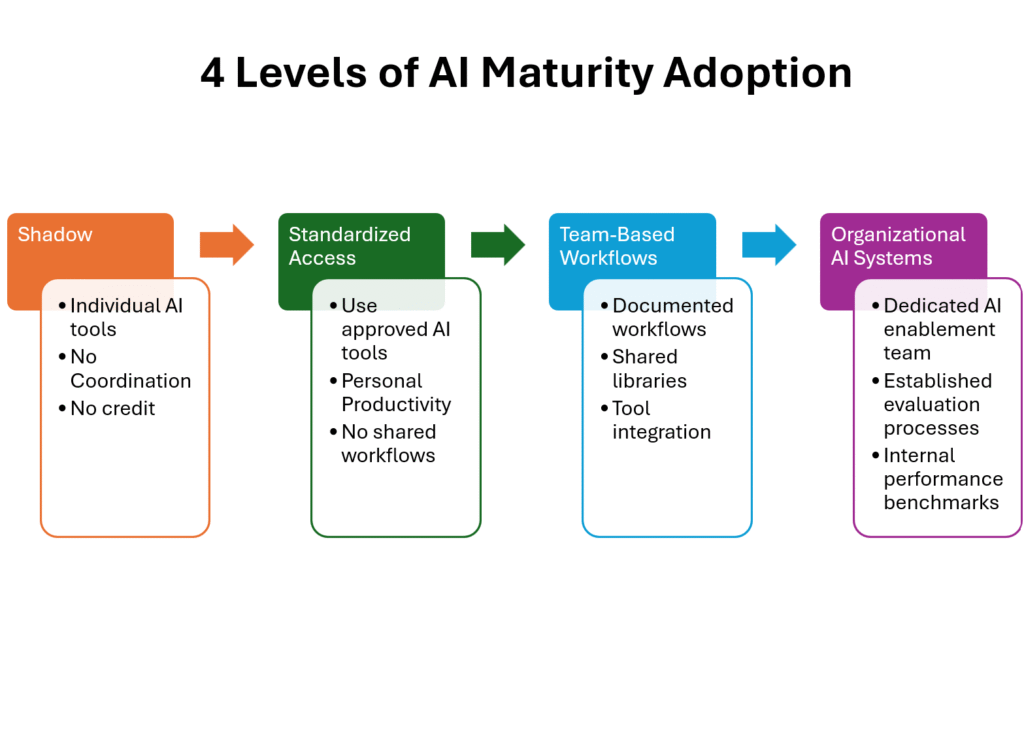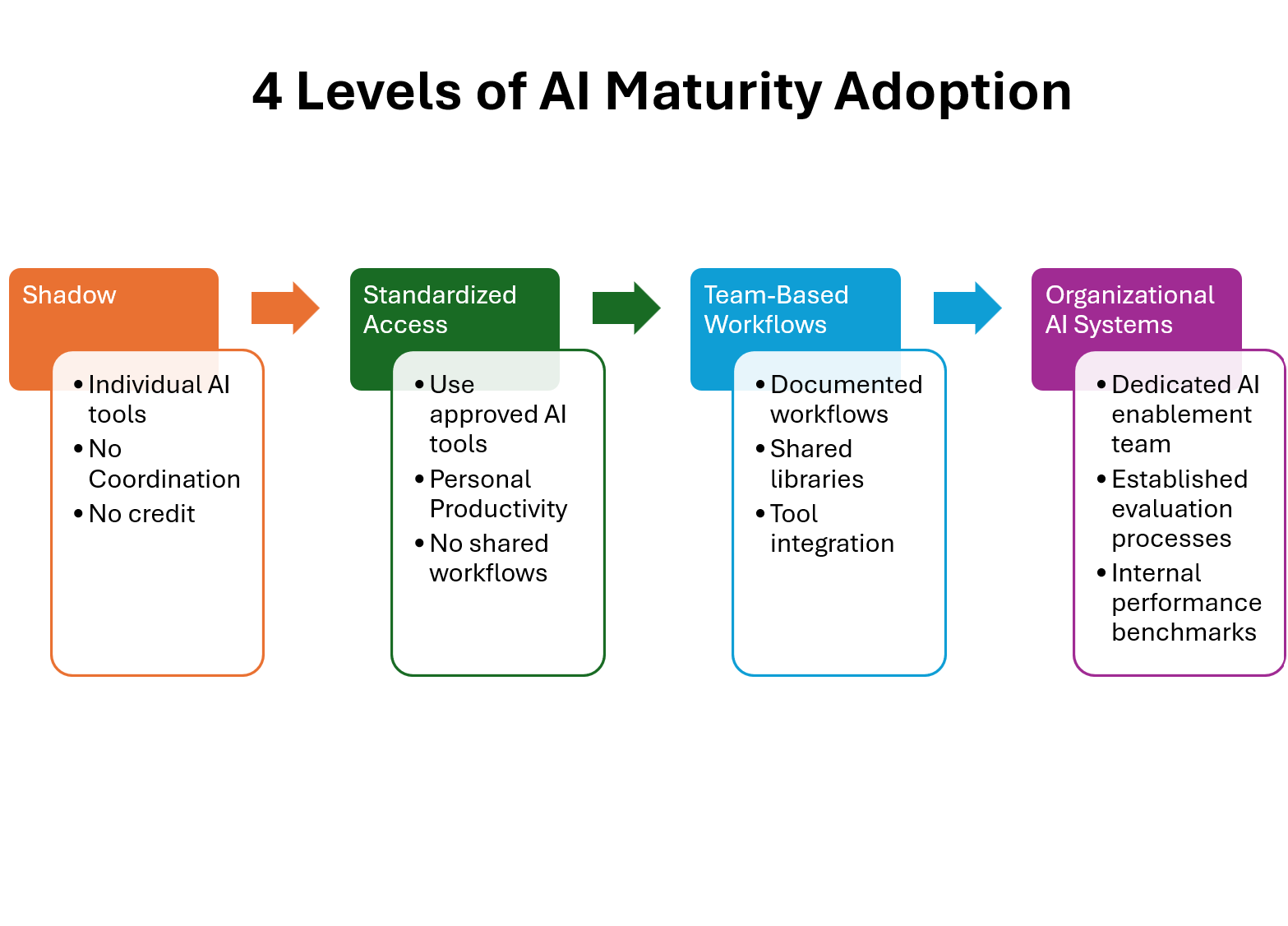Your teams are using AI tools for individual tasks, but your organization hasn’t developed coordinated AI capabilities. A fragmented AI implementation limits the business value you get from AI investments, and individual productivity gains don’t translate into team-level improvements or organizational competitive advantages.
Organizations that struggle with this type of AI coordination challenge often face similar issues when adopting any new technology or capability. In this post, we will uncover 4 levels of AI maturity that organizations go through, and we will also tackle broader aspects of organizational design that make it easier to adapt to changes.
The 4 Levels of AI Maturity in Organizations
Here’s how companies actually evolve their AI capabilities and build sustainable competitive advantages:
Level 0: AI Resistance
“AI is not for us.” Organizations remain here due to security concerns, regulatory constraints, or cultural resistance to AI adoption.
Level 1: Shadow AI Usage
People use AI tools individually without coordination or discussion. Product managers have personal ChatGPT subscriptions, designers experiment with AI image generators, and developers use GitHub Copilot, but nobody discusses it openly. AI usage is fragmented across different tools and approaches.
Key indicator: Teams produce AI-assisted work but don’t credit AI assistance or share AI strategies.
Level 2: Standardized Individual AI Access
The organization selects specific AI tools and provides universal access. Everyone uses the same ChatGPT Enterprise account or Claude for Teams subscription. AI usage becomes visible and sanctioned, but remains individual rather than collaborative.
Key indicator: People use approved AI tools for personal productivity but haven’t developed shared AI workflows.
Level 3: Team-Based AI Workflows
Teams develop shared AI processes and resources for organizational success. This includes AI prompt libraries for common tasks, custom GPTs or AI assistants for specific functions, AI integrations within existing team tools, and documented workflows for AI-assisted processes.
Key indicator: Teams have established patterns for how they collectively use AI to complete projects and drive business outcomes.
Level 4: Organizational AI Systems
Centralized AI capabilities with proper governance and measurement. Organizations develop dedicated AI enablement teams, evaluation processes for new AI models, internal benchmarks for AI tool performance, and organization-wide visibility into AI usage and outcomes.
Key indicator: AI capabilities are treated as business-critical infrastructure with dedicated resources and measured performance.

Getting Started with Team AI Implementation
If your organization feels stuck at Level 2 AI maturity, focus on enabling just one team to develop Level 3 AI capabilities:
- Pick a willing team: Choose a team that’s already experimenting with AI and has measurable work outputs.
- Create shared AI resources: Start with five to ten proven AI prompts for common team tasks like code reviews, tests, documentation, or competitive analysis. Build team-specific GPTs or Claude Projects loaded with your style guides, product requirements, or coding standards.
- Integrate AI into existing tools: Use Zapier or custom integrations to bring AI capabilities into tools teams already use: Slack, Notion, Linear, or Figma. Establish team standards for AI-assisted work and quality processes.
- Measure and iterate AI performance: Track task completion times, iteration cycles, and output quality before and after implementing team AI workflows. Monitor which AI applications produce the most value for your team’s specific work patterns.
- Share AI results: Document which AI workflows work and share them with other teams facing similar challenges. Create feedback loops to inform what AI capabilities to scale and what to discontinue.
The Strategic Path Forward for AI Organizational Success
AI maturity isn’t about having the most advanced AI technology. It’s about building organizational capability to apply AI meaningfully to real business problems and drive competitive advantage.
Most companies are still somewhere between Level 2 and Level 3 in their AI implementation, and it’s not until Level 4 that the real competitive advantage gets built through systematic AI adoption. But here’s the broader lesson: AI adoption is just the latest example of how organizations must systematically build new capabilities to remain competitive.
Client/server architectures, web-based applications, digital transformation, mobile-first strategies, continuous delivery, cloud migration, and now AI implementation. The technologies were different, but organizations faced the same fundamental challenges: existing processes and incentives resisted change, teams couldn’t align on new approaches, new initiatives competed with existing priorities for resources, leaders struggled to coordinate adoption across multiple departments, cultural resistance emerged (“this is how we’ve always done it”), people lacked the skills needed for new capabilities, and rigid processes prevented rapid adaptation.
High-performing organizations develop systematic approaches for managing organizational change. They have deliberate strategies for culture change, leadership alignment, organizational structure, people development, governance and funding, as well as agile ways of working, all of which enable rapid capability building and organizational transformation.
These companies don’t just succeed with AI adoption, but are better positioned to adapt to whatever new technology or market shift comes next.
If your organization struggles with these capability-building challenges, our Building High-Performing Organizations workshop teaches the systematic approaches that enable rapid adaptation and sustained competitive advantage.
For teams needing hands-on AI implementation skills, we also offer a GenAI for Product Managers workshop focused on practical prompt engineering and AI workflows.
